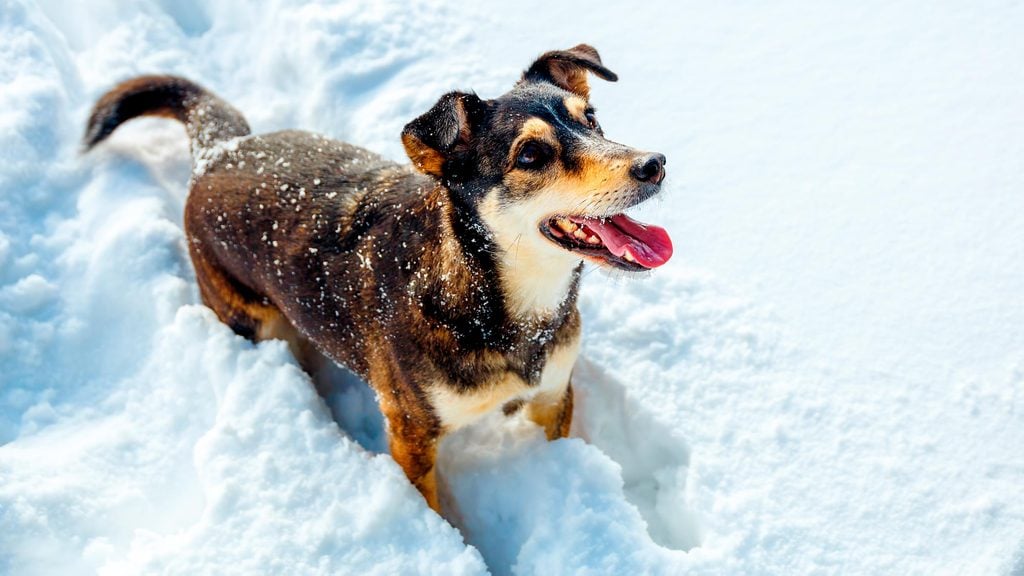When Is It Too Cold for Dogs to Go Outside?
Updated: Dec. 22, 2022

Dogs aren’t immune to the cold temperatures of winter. Make sure you know the facts so your dog doesn’t suffer.
Dogs, just like humans, can get chilly when the temperature starts to drop. We can layer on scarves, coats, hats, and gloves, but dogs don’t really have access to winter accessories the way we do—or they just refuse to wear them. If you live in a cold climate, it’s important to know your dog’s limits and how you can keep them safe and warm. Make sure to memorize these other important tips for keeping your pets safe in the winter.
On This Page
When is it too cold for a dog to go outside?
“It heavily depends on the dog breed as size, coat thickness and color, age and other factors but in general, when the temperature hits below 45 degrees Fahrenheit, most dogs start to feel the cold,” says Dr. Gary Richter, a veterinary health expert with Rover. However, he says when it goes below 32 degrees Fahrenheit is when they can actually start to get hurt from the cold.
In many parts of the world, the temperature remains below 32 degrees for multiple months at a time. Since dogs obviously can’t be cooped up inside all day during the winter season, the most important thing to remember is to pay attention to your dog when you take them out. They will typically let you know if they are uncomfortable.
The actual temperature is really just part of the equation. You also have to take into account wind chill, dampness, and cloud cover, says Dr. Richter. The windier, wetter, and darker it is outside, the colder it is going to feel.
What dogs are comfortable in the snow and what dogs can’t stand it?
“Thinner dogs tend to get colder quicker than larger dogs as body fat is a good insulator,” says Dr. Richter. The thickness and color of their coat can also play into how quickly they’ll get cold. A dog with a thick coat like a Husky will be able to stay out in the cold for much longer than a dog with a very thin coat, such as a Greyhound. Also, if dogs have a darker coat, such as a Bernese Mountain Dog, they’ll remain warm on sunny days since their coat will absorb heat from the sunlight.
How long should dogs be outside for when it is cold?
“Dogs can go outside for 15 to 20 minutes at below-freezing temperatures to use the bathroom and play,” says Sara Ochoa, DVM. She reiterates that you should keep a close eye on your dog while you’re outside to make sure that they’re not showing any signs of discomfort. If dogs are outside for too long they can have trouble regulating their body temperature and freeze.
What signs does a dog give when they are cold?
If you see that your dog is shivering, acting anxious, whining, slowing down, searching out warm locations, or holding up one or more paws you need to start to head inside. Dogs have similar traits to humans when they want to get out of the cold.
What happens to a dog’s health if they are outside in dangerously cold temperatures for too long?
“If the temperature drops below 20 degrees Fahrenheit, dogs could potentially develop cold-associated health issues like hypothermia and frostbite but it’s not very common,” says Dr. Richter.
Another health hazard you need to watch out for in the winter is the salt that is used to de-ice roads and walkways. It can cause your dog’s paw pads to peel off, leaving a layer of fresh, sensitive skin exposed which can be painful to walk on. Make sure to wash your dog’s feet with warm water when they return indoors.
You should also steer your dog clear of icy areas because they can fall and hurt themselves just like humans, especially older dogs that may not be able to react as fast.
How can you protect your dog from the cold?
If your dog isn’t a breed that can withstand the cold well, getting them a coat can be helpful. Make sure that the coat is snug but still allows your dog to have a full range of motion. If you’re in a damp climate or need to take your dog out in the snow, make sure that the coat is waterproof to keep their fur from getting wet. To protect their feet you can get booties or purchase paw pad wax to protect their paw pads. If you need some inspiration, these are some of the best dog coats for winter.



